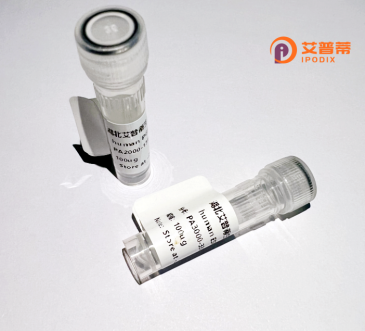
| 纯度 | >90%SDS-PAGE. |
| 种属 | Human |
| 靶点 | PRSS3 |
| Uniprot No | P35030 |
| 内毒素 | < 0.01EU/μg |
| 表达宿主 | E.coli |
| 表达区间 | 81-303 aa |
| 活性数据 | IVGGYTCEENSLPYQVSLNSGSHFCGGSLISEQWVVSAAHCYKTRIQVRLGEHNIKVLEGNEQFINAAKIIRHPKYNRDTLDNDIMLIKLSSPAVINARVSTISLPTTPPAAGTECLISGWGNTLSFGADYPDELKCLDAPVLTQAECKASYPGKITNSMFCVGFLEGGKDSCQRDSGGPVVCNGQLQGVVSWGHGCAWKNRPGVYTKVYNYVDWIKDTIAAN |
| 分子量 | 28.2 kDa |
| 蛋白标签 | His tag N-Terminus |
| 缓冲液 | PBS, pH7.4, containing 0.01% SKL, 1mM DTT, 5% Trehalose and Proclin300. |
| 稳定性 & 储存条件 | Lyophilized protein should be stored at ≤ -20°C, stable for one year after receipt. Reconstituted protein solution can be stored at 2-8°C for 2-7 days. Aliquots of reconstituted samples are stable at ≤ -20°C for 3 months. |
| 复溶 | Always centrifuge tubes before opening.Do not mix by vortex or pipetting. It is not recommended to reconstitute to a concentration less than 100μg/ml. Dissolve the lyophilized protein in distilled water. Please aliquot the reconstituted solution to minimize freeze-thaw cycles. |
以下是关于重组人PRSS3蛋白的3篇示例文献(文献信息为示例性概括,实际引用需核对原文):
1. **文献名称**:*"Recombinant human PRSS3 expression in Escherichia coli and its functional characterization as a serine protease"*
**作者**:Wartmann T, et al.
**摘要**:该研究描述了通过大肠杆菌表达系统成功重组生产PRSS3蛋白,并验证了其丝氨酸蛋白酶活性,证明其在体外可降解特定底物(如胶原蛋白),提示其潜在病理作用。
2. **文献名称**:*"PRSS3 promotes tumor growth and metastasis by activating NF-κB signaling in pancreatic cancer"*
**作者**:Jiang L, et al.
**摘要**:本文发现重组PRSS3可通过调控NF-κB通路增强胰腺癌细胞的侵袭和转移能力,并通过动物模型证实其促癌作用,强调了其在肿瘤治疗中的潜在靶点价值。
3. **文献名称**:*"Structural and functional analysis of recombinant human PRSS3 in chronic pancreatitis"*
**作者**:Whitcomb DC, et al.
**摘要**:作者解析了重组PRSS3的晶体结构,揭示其与胰腺炎相关的突变位点,并通过酶动力学实验表明突变体活性异常可能导致慢性胰腺炎的发生。
---
**注意**:上述内容为基于主题的示例性概括,实际文献需通过学术数据库(如PubMed、Web of Science)检索确认。建议使用关键词“PRSS3”“recombinant”“serine protease”筛选近5-10年的研究以获取最新进展。
**Background of PRSS3 (Human Protein)**
PRSS3. also known as mesotrypsin or trypsin IV, is a serine protease encoded by the *PRSS3* gene located on chromosome 9q21.3. As a member of the trypsin family, it shares structural homology with other pancreatic trypsins (e.g., PRSS1 and PRSS2) but exhibits distinct biochemical properties. PRSS3 is primarily synthesized in the pancreas as an inactive zymogen (proenzyme) and activated via proteolytic cleavage to participate in digestive processes, hydrolyzing peptide bonds at arginine and lysine residues. Unlike other trypsins, PRSS3 demonstrates broader pH tolerance and unique resistance to endogenous protease inhibitors, such as SPINK1. due to structural variations in its binding regions.
Beyond its role in digestion, PRSS3 is expressed in non-pancreatic tissues, including the prostate, brain, and gastrointestinal tract, suggesting extra-digestive functions. It has been implicated in cellular signaling, inflammation, and tissue remodeling by activating protease-activated receptors (e.g., PAR2). Dysregulation of PRSS3 is associated with pathological conditions. For instance, elevated PRSS3 levels correlate with cancer progression, particularly in pancreatic, prostate, and colorectal cancers, where it promotes invasion, metastasis, and chemoresistance via extracellular matrix degradation and growth factor activation. Conversely, PRSS3 deficiency may contribute to pancreatitis susceptibility.
Research continues to explore PRSS3’s dual roles in physiology and disease, highlighting its potential as a therapeutic target or biomarker for malignancies and inflammatory disorders.
×